Block-Based Mode Decomposition in Few-Mode Fibers
Abstract
1. Introduction
2. Materials and Methods
3. Results
3.1. Simulation
3.1.1. Mode Decomposition Without Noise
3.1.2. Mode Decomposition with Noise
3.2. Experiment
4. Conclusions
Author Contributions
Funding
Institutional Review Board Statement
Informed Consent Statement
Data Availability Statement
Conflicts of Interest
References
- Lv, J.; Li, H.; Zhang, Y.; Tao, R.; Dong, Z.; Gu, C.; Yao, P.; Zhu, Y.; Chen, W.; Zhan, Q.; et al. Few-mode random fiber laser with a switchable oscillating spatial mode. Opt. Express 2020, 28, 38973–38982. [Google Scholar] [CrossRef] [PubMed]
- Chen, X.; Yao, T.; Huang, L.; An, Y.; Wu, H.; Pan, Z.; Zhou, P. Functional fibers and functional fiber-based components for high-power lasers. Adv. Fiber Mater. 2023, 5, 59–106. [Google Scholar] [CrossRef]
- Zhang, X.; Gao, S.; Wang, Y.; Ding, W.; Wang, P. Design of large mode area all-solid anti-resonant fiber for high-power lasers. High Power Laser Sci. Eng. 2021, 9, e23. [Google Scholar] [CrossRef]
- Wang, Y.; Tang, Y.; Yan, S.; Xu, J. High-power mode-locked 2 µm multimode fiber laser. Laser Phys. Lett. 2018, 15, 085101. [Google Scholar] [CrossRef]
- Richardson, D.J.; Fini, J.M.; Nelson, L.E. Space-division multiplexing in optical fibres. Nat. Photonics 2013, 7, 354–362. [Google Scholar] [CrossRef]
- Rademacher, G.; Puttnam, B.J.; Luis, R.S.; Eriksson, T.A.; Fontaine, N.K.; Mazur, M.; Chen, H.; Ryf, R.; Neilson, D.T.; Sillard, P.; et al. Ultra-wide band transmission in few-mode fibers. In Proceedings of the 2021 European Conference on Optical Communication (ECOC), Bordeaux, France, 13–16 September 2021; IEEE: Piscataway, NY, USA, 2021; pp. 1–4. [Google Scholar]
- Zuo, M.; Ge, D.; Liu, J.; Gao, Y.; Shen, L.; Lan, X.; Chen, Z.; He, Y.; Li, J. Long-haul intermodal-MIMO-free MDM transmission based on a weakly coupled multiple-ring-core few-mode fiber. Opt. Express 2022, 30, 5868–5878. [Google Scholar] [CrossRef]
- Qiu, Y.; Xu, J.; Wong, K.K.; Tsia, K.K. Exploiting few mode-fibers for optical time-stretch confocal microscopy in the short near-infrared window. Opt. Express 2012, 20, 24115–24123. [Google Scholar] [CrossRef]
- Diab, M.; Dinkelaker, A.N.; Davenport, J.; Madhav, K.; Roth, M.M. Starlight coupling through atmospheric turbulence into few-mode fibres and photonic lanterns in the presence of partial adaptive optics correction. Mon. Not. R. Astron. Soc. 2021, 501, 1557–1567. [Google Scholar] [CrossRef]
- Renninger, W.H.; Wise, F.W. Optical solitons in graded-index multimode fibres. Nat. Commun. 2013, 4, 1719. [Google Scholar] [CrossRef] [PubMed]
- Wright, L.G.; Christodoulides, D.N.; Wise, F.W. Controllable spatiotemporal nonlinear effects in multimode fibres. Nat. Photonics 2015, 9, 306–310. [Google Scholar] [CrossRef]
- Mangini, F.; Gervaziev, M.; Ferraro, M.; Kharenko, D.; Zitelli, M.; Sun, Y.; Couderc, V.; Podivilov, E.; Babin, S.; Wabnitz, S. Statistical mechanics of beam self-cleaning in GRIN multimode optical fibers. Opt. Express 2022, 30, 10850–10865. [Google Scholar] [CrossRef] [PubMed]
- Shapira, O.; Abouraddy, A.F.; Joannopoulos, J.D.; Fink, Y. Complete modal decomposition for optical waveguides. Phys. Rev. Lett. 2005, 94, 143902. [Google Scholar] [CrossRef] [PubMed]
- Brüning, R.; Gelszinnis, P.; Schulze, C.; Flamm, D.; Duparré, M. Comparative analysis of numerical methods for the mode analysis of laser beams. Appl. Opt. 2013, 52, 7769–7777. [Google Scholar] [CrossRef]
- Lü, H.; Zhou, P.; Wang, X.; Jiang, Z. Fast and accurate modal decomposition of multimode fiber based on stochastic parallel gradient descent algorithm. Appl. Opt. 2013, 52, 2905–2908. [Google Scholar] [CrossRef]
- Chen, F.; Zhao, S.; Wang, Q.; Ma, J.; Lu, Q.; Wan, J.; Xie, R.; Zhu, R. Modal decomposition of a fibre laser beam based on the push-broom stochastic parallel gradient descent algorithm. Opt. Commun. 2021, 481, 126538. [Google Scholar] [CrossRef]
- Jiang, M.; Wu, H.; An, Y.; Hou, T.; Chang, Q.; Huang, L.; Li, J.; Su, R.; Zhou, P. Fiber laser development enabled by machine learning: Review and prospect. PhotoniX 2022, 3, 16. [Google Scholar] [CrossRef]
- Tian, Z.; Pei, L.; Wang, J.; Hu, K.; Xu, W.; Zheng, J.; Li, J.; Ning, T. High-performance mode decomposition using physics-and data-driven deep learning. Opt. Express 2022, 30, 39932–39945. [Google Scholar] [CrossRef] [PubMed]
- Yan, B.; Zhang, J.; Wang, M.; Jiang, Y.; Mi, S. Degenerated mode decomposition with convolutional neural network for few-mode fibers. Opt. Laser Technol. 2022, 154, 108287. [Google Scholar] [CrossRef]
- Zhao, J.; Chen, G.; Bi, X.; Cai, W.; Yue, L.; Tang, M. Fast mode decomposition for few-mode fiber based on lightweight neural network. Chin. Opt. Lett. 2024, 22, 020604. [Google Scholar] [CrossRef]
- Manuylovich, E.S.; Dvoyrin, V.V.; Turitsyn, S.K. Fast mode decomposition in few-mode fibers. Nat. Commun. 2020, 11, 5507. [Google Scholar] [CrossRef]
- Wang, C.; Zhang, J.; Yan, B.; Mi, S.; Fan, G.; Wang, M.; Zhang, P. Spatially degenerated mode decomposition for few-mode fibers. Opt. Fiber Technol. 2024, 85, 103781. [Google Scholar] [CrossRef]
- Choi, K.; Jun, C. Sub-sampled modal decomposition in few-mode fibers. Opt. Express 2021, 29, 32670–32681. [Google Scholar] [CrossRef] [PubMed]
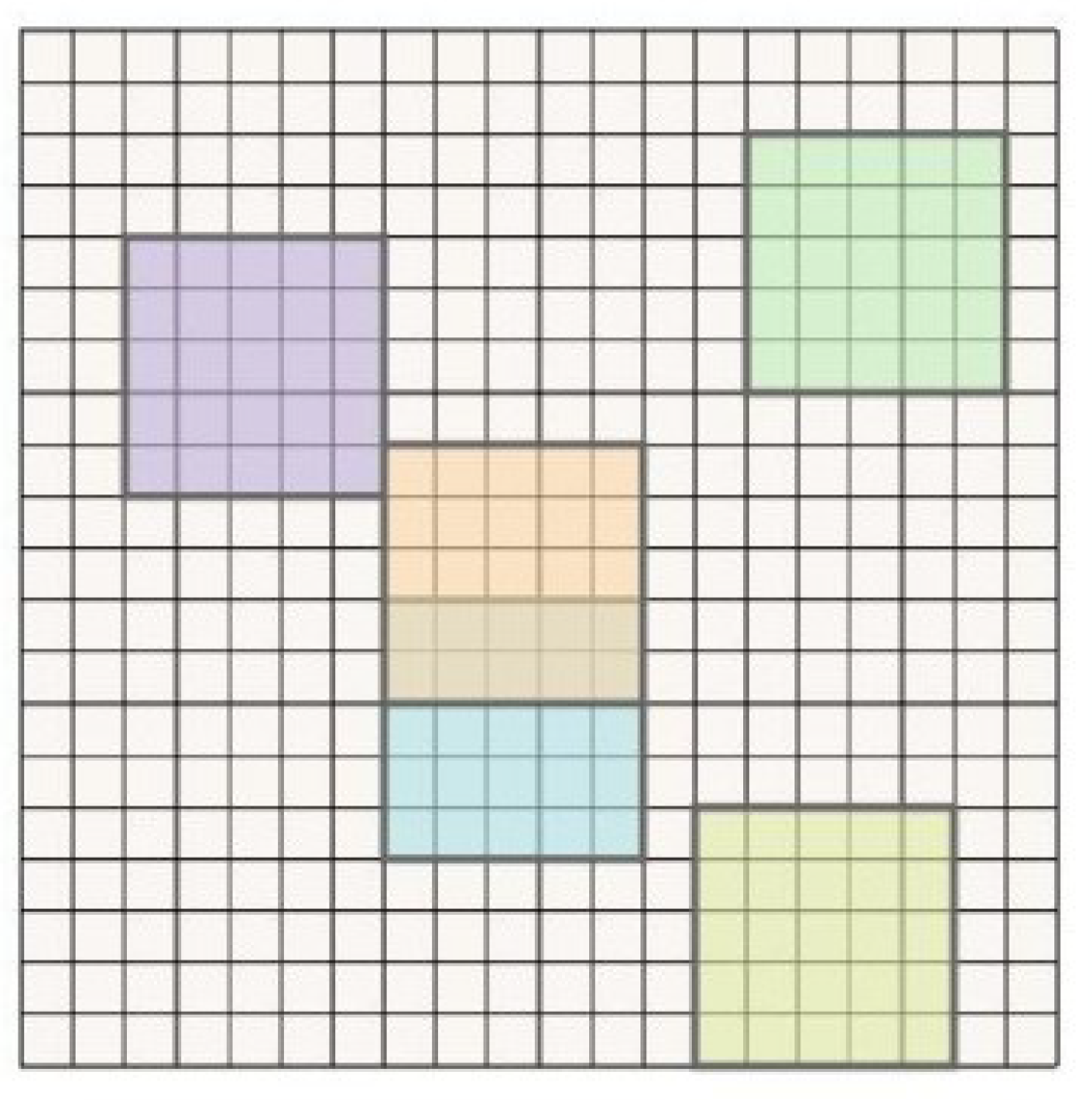

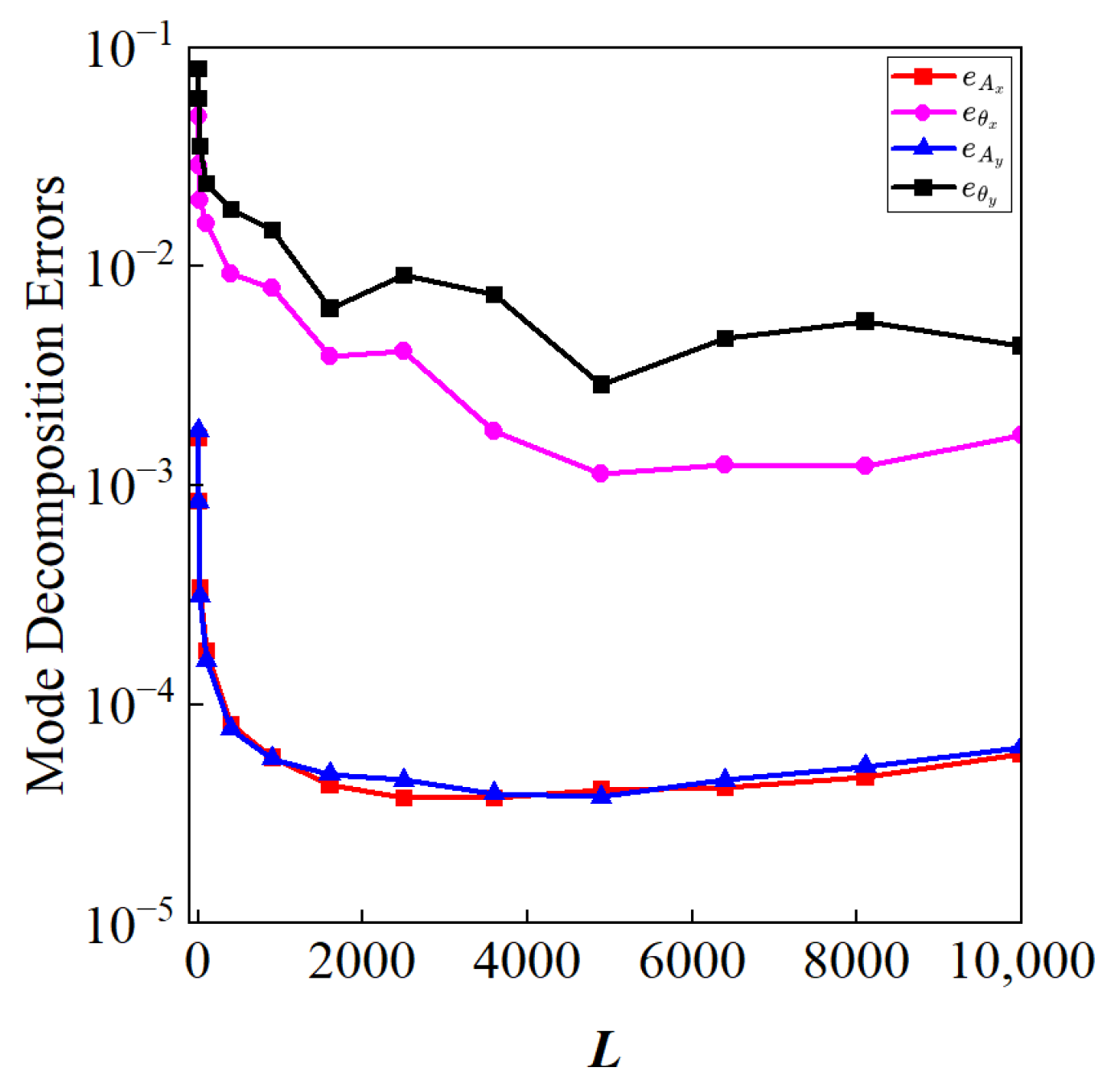
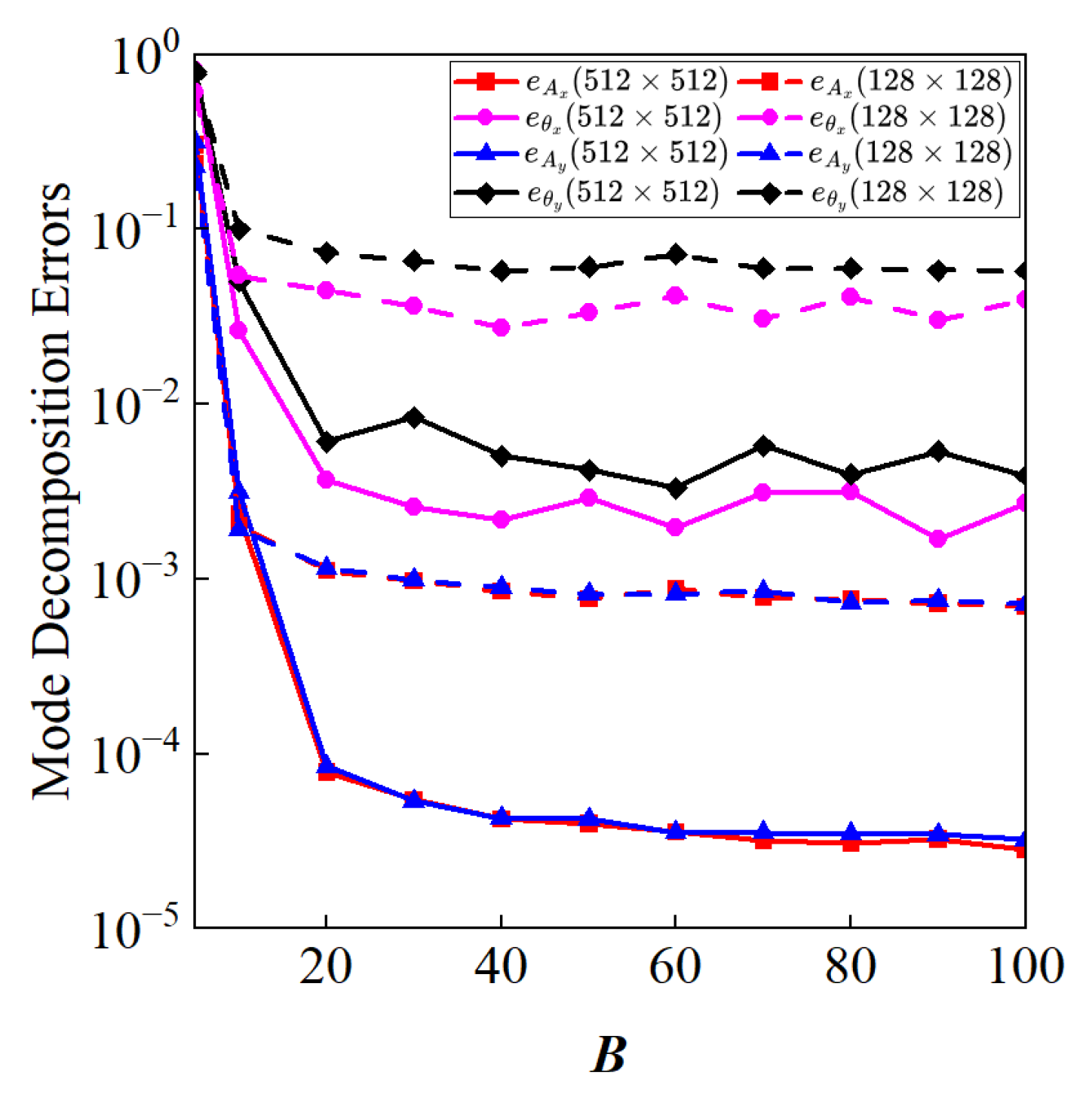
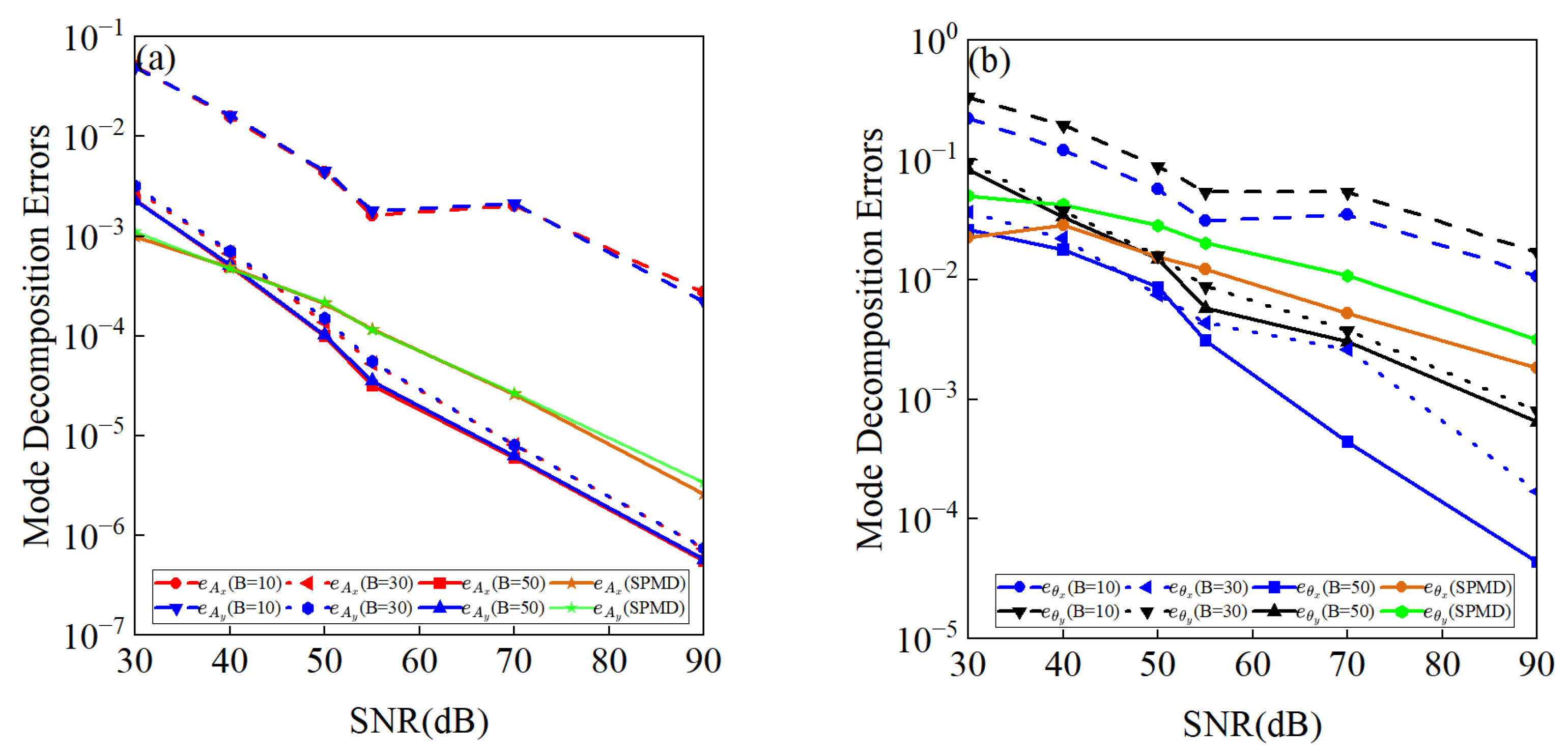

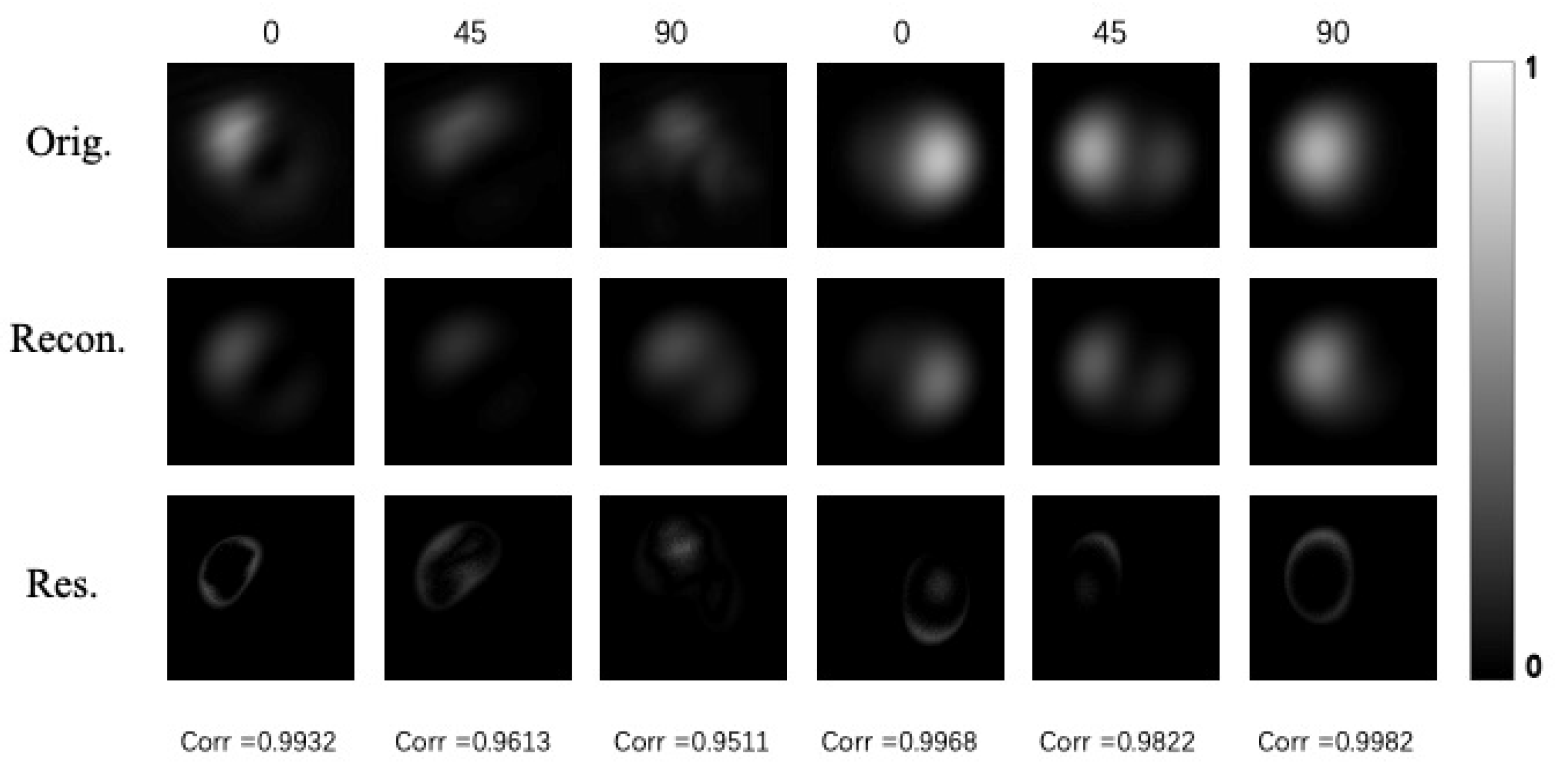
| SPMD () | 0.9855 | 0.9609 | 0.9200 |
| BMD | 0.9932 | 0.9613 | 0.9511 |
Disclaimer/Publisher’s Note: The statements, opinions and data contained in all publications are solely those of the individual author(s) and contributor(s) and not of MDPI and/or the editor(s). MDPI and/or the editor(s) disclaim responsibility for any injury to people or property resulting from any ideas, methods, instructions or products referred to in the content. |
© 2025 by the authors. Licensee MDPI, Basel, Switzerland. This article is an open access article distributed under the terms and conditions of the Creative Commons Attribution (CC BY) license (https://creativecommons.org/licenses/by/4.0/).
Share and Cite
Wang, C.; Zhang, J.; Yan, B.; Mi, S.; Fan, G.; Wang, M.; Zhang, P. Block-Based Mode Decomposition in Few-Mode Fibers. Photonics 2025, 12, 66. https://doi.org/10.3390/photonics12010066
Wang C, Zhang J, Yan B, Mi S, Fan G, Wang M, Zhang P. Block-Based Mode Decomposition in Few-Mode Fibers. Photonics. 2025; 12(1):66. https://doi.org/10.3390/photonics12010066
Chicago/Turabian StyleWang, Chenyu, Jianyong Zhang, Baorui Yan, Shuchao Mi, Guofang Fan, Muguang Wang, and Peiying Zhang. 2025. "Block-Based Mode Decomposition in Few-Mode Fibers" Photonics 12, no. 1: 66. https://doi.org/10.3390/photonics12010066
APA StyleWang, C., Zhang, J., Yan, B., Mi, S., Fan, G., Wang, M., & Zhang, P. (2025). Block-Based Mode Decomposition in Few-Mode Fibers. Photonics, 12(1), 66. https://doi.org/10.3390/photonics12010066






